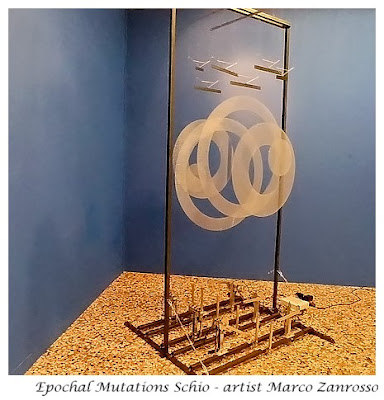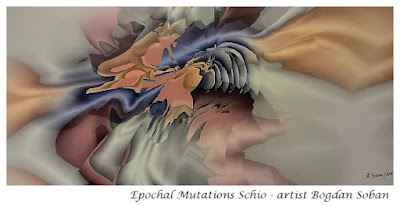Finally the Covid-19 lockdowns are easing and cultural events are being organised. Recently, our city organised a contemporary art exhibition called "Epochal Mutations" (MutAzioni Epocali). When I read the name of the exhibition, I thought that it would be totally influenced by the Covid-19 lockdown and would have a lot of works expressing anguish and fear. So I was not so sure if I wanted to look at it. Fortunately, I changed my mind and visited it - it had a lot of works which I liked. It also introduced me to the works of many new local artists and a few outside artists.
"Mutation" Art Exhibitions have been held in Schio since 2017, but its focus changes every year. For example, in 2019, it was "MutAzioni Spaziali" (Space Mutations). Due to the Covid-19 Pandemic, it was not held in 2020.
This year the exhibition was held at Palazzo Fogazzaro, a historical building in the city centre from 1810. In the courtyard there was a work of our Schio sculptor
Mario Converio, who works with iron and metals. He is famous for his voluptuous female forms and I had written a post about him. His work for this exhibition is a globe with a storm of birds rising up from it. After this exhibition, this sculpture will be placed in the Schio railway station and will become a public art installation. (Click on the images for a bigger view)
In this post I am presenting some of the artists from MotAzioni Epocali exhibition whose works I liked - they are not in any particular order.
During the exhibition, I met one of the artists - her name is
Maria Grazia Martina - I will start with her. Her background is in history of art and she teaches in a school. She creates art with mixed materials. I asked her if her background in the history of art influences her as an artist? She said that it was more of a hindrance because she tends to compare of her works with those of well-known artists that she had studied and this makes her feel very self-critical. I could empathise with her feelings because self-criticism is a big challenge for a lot of artists and it is great that in spite of it, she can express her creativity. You can see her with some of her works in the image below.
The next image again shows the details of one of the works of Maria Grazia Martina, which I liked because of the vibrant colours of the fibres which express for me the confusion, interconnections and vitality of life.
The artist
Claudio Brunello from Bassano had two works in the exhibition, one on the women of Afghanistan and another on languages and technology - I liked both of them. In the second work, he had used a lot of 3-D printed miniature human figures to express ideas about native languages while computer motherboards expressed use of the increasing use of English coupled with technology - I thought that that it was ironic that he expressed traditions part of this work through 3D printed figures. You can see details from this work in the image below.
Marco Zanrosso's installation "Ecological Equilibrium" had six semi-transparent circles, one in front of the other, moving up and down, creating ever-changing dynamic forms was very beautiful even if the ideas it expressed were too abstract. A large part of its beauty came from the constant movement of the circles and their translucent materials - both these aspects are difficult to appreciate in the image below.

There were many digital works in the exhibition. I understand that artistic expression can not be limited by the materials used by the artists and thus digital art is one such legitimate expression of creativity. However, I feel that having the skills of computer graphics is a different kind of artistic skill and needs to have its own separate art-world, it can't be mixed with art created by persons, using their hands in the the old- fashioned way. Like the works of Claudio Brunello above, I can also see that setting the boundaries between digital and non-digital would anyway be a difficult exercise. Among the artists presenting digital prints, I liked the work of Valeria Cassol, which was titled "When you look up and see the Universe", shown in the image below.
I also liked the digital prints of Slovenian artist
Bogdan Soban - with their delicate colours and complex abstract forms, they invited you to look at them and get lost in their details. In fact, I spent a long time looking at his work presented in the image below.
Simone Ricciardello from Vicenza had 2 installations about climate change. One was called "Alone no one will be saved", which was more explicit about its theme. It had an old table fan which started moving when someone came or passed in front of it and then automatically stopped. Another of his installation, "The time of non-return" had a baby angel setup against green tiles and it expressed the time running out to save the planet.
The installations of the Schio artist
Elisa Pedron expressed ideas of reincarnation, mutation and evolving through the mythical fire-bird Phoenix and a cosmic egg. You can see her cosmic egg in the banner of this post above while the image below shows the metal circles and the phoenix.
I especially loved the works of Luca Vallortigara, who had used abstract figures in wood to express its different natural colours and textures, which had the power to draw me into introspection and wondering about the meanings of life and nature.
I also liked the multi-material works of
Paolo Guglielmo Giorio like the one in the image below that was supposed to express the virus of Covid-19 together with the sea-life suffocated by petrol-spill from a big ship. I think that this was the only work in the whole exhibition which directly mentioned the Covid-19 pandemic. I liked the way the fish-net and the red virus came together against the grey background and the rotting skull (in the image below).
The work of Schio artist Elena Ester Accardo, "After the floods" was supposed to express a recurrent dream which has had. With delicate gold and greens, it had a very pleasing impact, the kind of art you can look at when you are feeling low and feel uplifted by it! While it had an immediate pleasing impact, it also had a complex mix of symbols, which kept me gazing at it and trying to discern their meanings.
The installation of the Schio artist
Rosa Paola Astrid represented the countdown clock on the climate change which was put up in Rome in June this year on the World Environment Day. It had paintings of the earth seen from space in changing colours, again giving an expression to the time running out.
The next image shows one of the works of
Martina Dalla Stella - it was called "No fear" and it expressed migrations, changing technology, role of police and big corporations and the courage of ordinary people to face them and to fight for rights.
I want to close with the work I liked most in this exhibition - I absolutely loved the mosaic like works of
Eva Trentin from Marano Vicentino, with each piece of the mosaic expressing nature, places and moments of life. I felt that I could look at them for hours, find new points of reflection and at the same time, feel an emotional connection with them. Below I have an image from her work "289", made of 289 pieces of mosaic.
Conclusions
As you can see, there were many interesting works in this exhibition. The most common theme chosen by the artists was about the climate change. My favourite works in this exhibition were by Eva Trentin and Elena Ester Accardo. Regarding the installations, I liked most the works of Marco Zanrosso and Claudio Brunello.
As I came out of the exhibition, I saw the sculptor Mario Converio at the gate. He had come to take measurements of his work in the courtyard as it has to be strengthened for its placement in the railway station. We went to a nearby bar to have a beer and to talk about his art and about life.
May be one day I will also write about that conversation with Mario Converio. In the mean time, I hope that you have liked this virtual walk-through at the MutAzioni Epocali exhibition. Even if Schio is a tiny little town, I think that in terms of culture, it is full of wonderful opportunities.
***























No comments:
Post a Comment
Thanks for visiting Arre Kya Baat Hai and for your comment! Please use a civilised language. Comments with embedded links are removed.